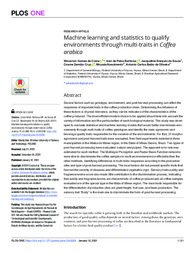Machine learning and statistics to qualify environments through multi-traits in Coffea arabica.
Machine learning and statistics to qualify environments through multi-traits in Coffea arabica.
Author(s): COSTA, W. G. da; BARBOSA, I. de P.; SOUZA, J. E. de; CRUZ, C. D.; NASCIMENTO, M.; OLIVEIRA, A. C. B. de
Summary: Several factors such as genotype, environment, and post-harvest processing can affect the responses of important traits in the coffee production chain. Determining the influence of these factors is of great relevance, as they can be indicators of the characteristics of the coffee produced. The most efficient models choice to be applied should take into account the variety of information and the particularities of each biological material. This study was developed to evaluate statistical and machine learning models that would better discriminate environments through multi-traits of coffee genotypes and identify the main agronomic and beverage quality traits responsible for the variation of the environments. For that, 31 morpho-agronomic and post-harvest traits were evaluated, from field experiments installed in three municipalities in the Matas de Minas region, in the State of Minas Gerais, Brazil. Two types of post-harvest processing were evaluated: natural and pulped. The apparent error rate was estimated for each method. The Multilayer Perceptron and Radial Basis Function networks were able to discriminate the coffee samples in multi-environment more efficiently than the other methods, identifying differences in multi-traits responses according to the production sites and type of post-harvest processing. The local factors did not present specific traits that favored the severity of diseases and differentiated vegetative vigor. Sensory traits acidity and fragrance/aroma score also made little contribution to the discrimination process, indicating that acidity and fragrance/aroma are characteristic of coffee produced and all coffee samples evaluated are of the special type in the Mata of Minas region. The main traits responsible for the differentiation of production sites are plant height, fruit size, and bean production. The sensory trait "Body" is the main one to discriminate the form of post-harvest processing.
Publication year: 2021
Types of publication: Journal article
Unit: Embrapa Coffee
Observation
Some of Embrapa's publications are published as ePub files. To read them, use or download one of the following free software options to your computer or mobile device. Android: Google Play Books; IOS: iBooks; Windows and Linux: Calibre.
Access other publications
Access the Agricultural Research Database (BDPA) to consult Embrapa's full library collection and records.
Visit Embrapa Bookstore to purchase books and other publications sold by Embrapa.

